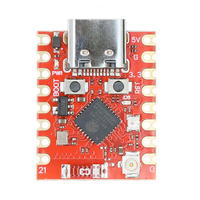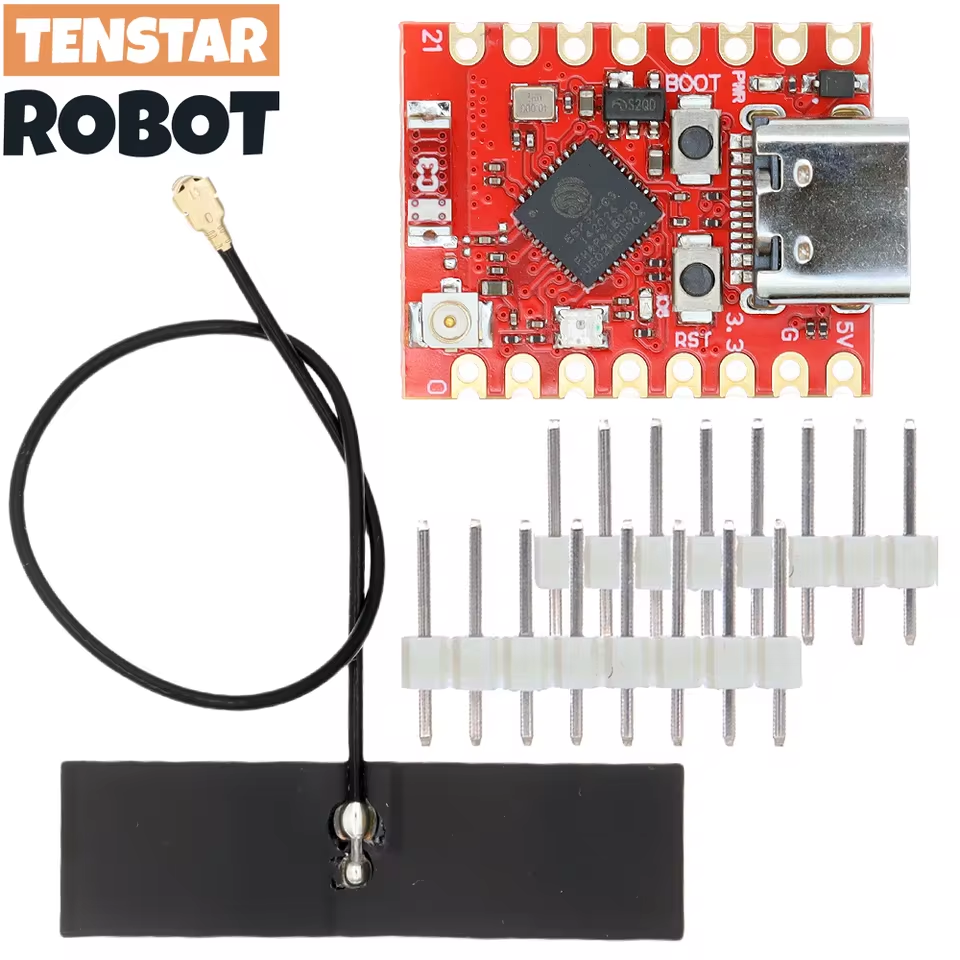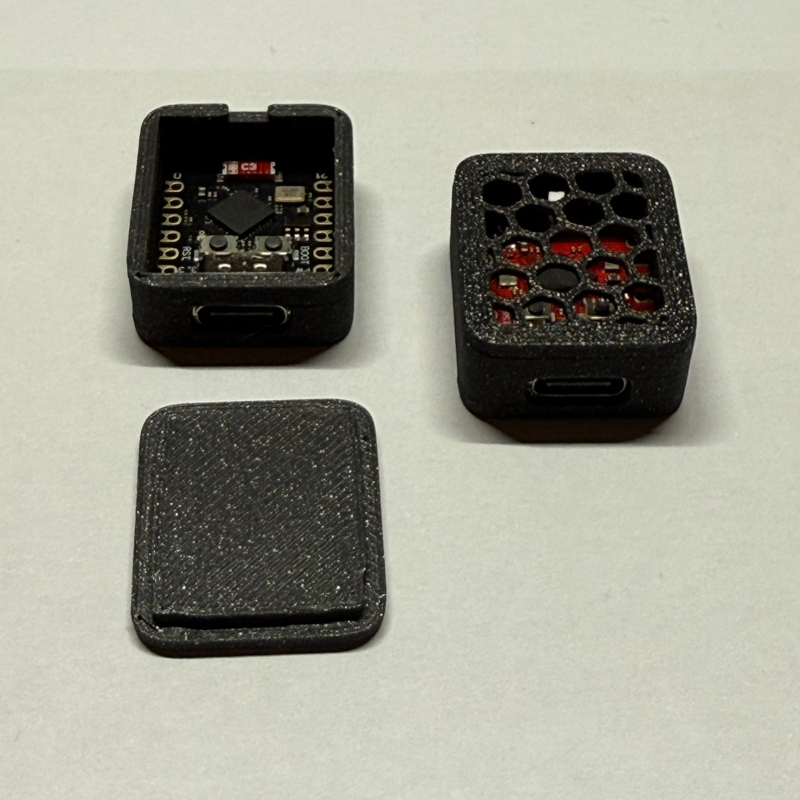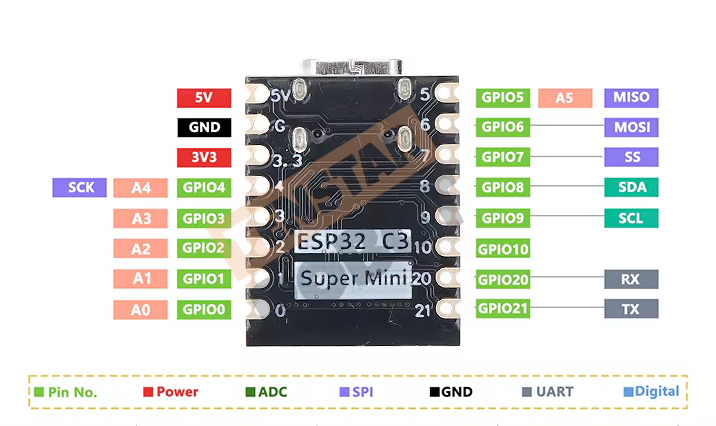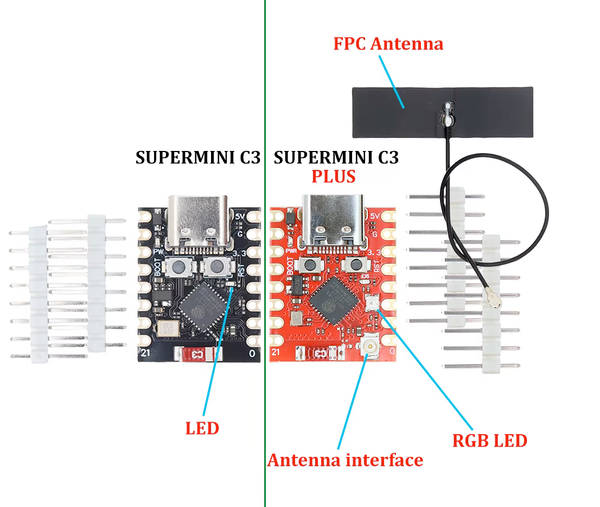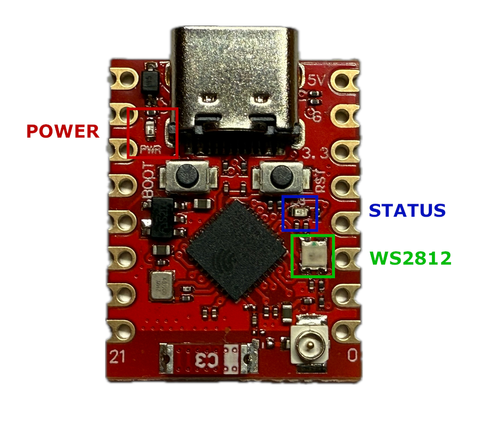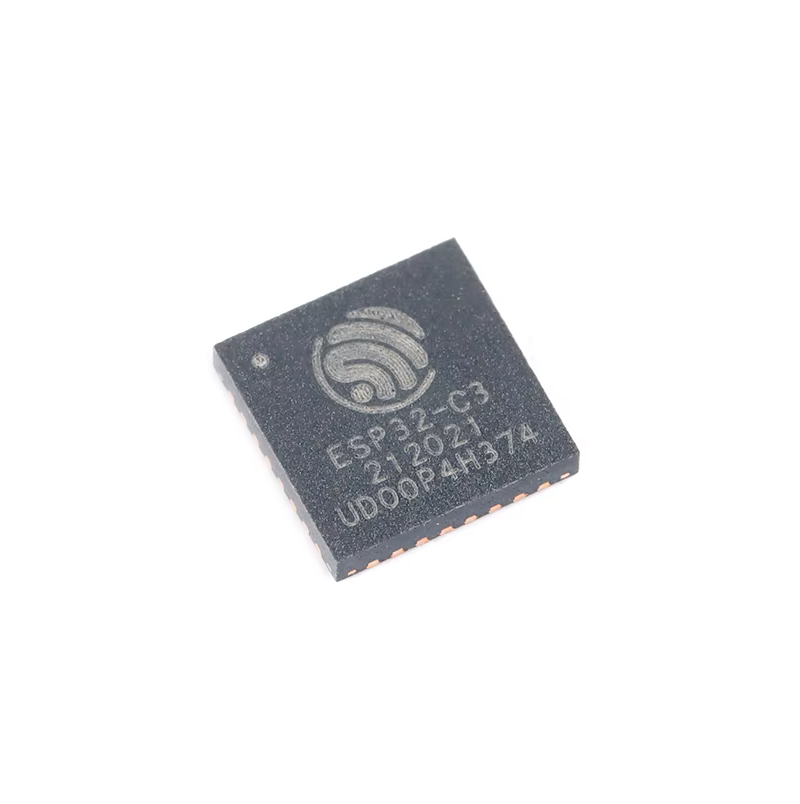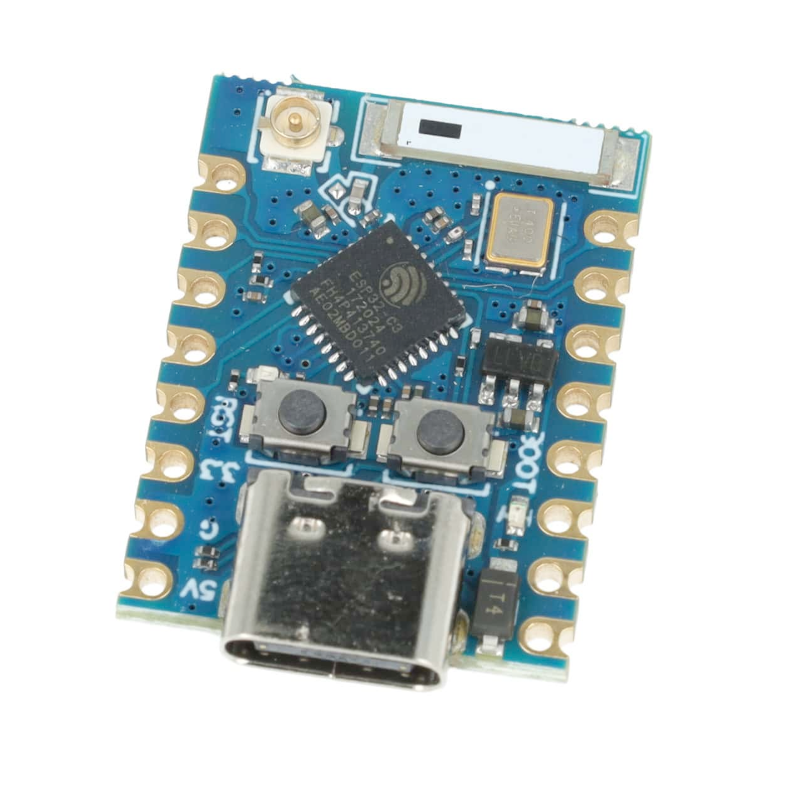ESP32 C3 Super Mini Plus Development Board
Code name: ESP32C3_DEV
ESP32 C3 Super Mini Plus development board is based on esp32c3 microcontroller and uses riscv32 architecture. This board has a maximum CPU frequency of 160 MHz and a flash size of 4MB.
About ESP32 C3 Super Mini Plus
⚠️ If you have the black pcb board, check ESP32 C3 Supermini
The ESP32-C3 SuperMini Plus is an enhanced IoT mini development board based on the Espressif ESP32-C3 WiFi/Bluetooth dual-mode chip. It shares the same core architecture as the standard SuperMini, featuring a 32-bit RISC-V CPU, 400 KB of SRAM, and 4 MB of flash memory. The board supports IEEE 802.11b/g/n WiFi and Bluetooth 5 (LE) protocols, ensuring robust connectivity.
A key difference between the two models is the antenna design. The SuperMini features a built-in small PCB antenna, whereas the SuperMini Plus comes with an external antenna that connects to the board via a U.FL connector, offering better range and signal strength for wireless applications.
The SuperMini Plus also comes in a distinct red PCB variant and features an onboard RGB LED, allowing for more flexible LED control compared to the single blue LED on the original SuperMini. This RGB LED enables users to program different colors for status indications, making it more versatile for IoT and embedded projects.
🆚 Wondering how the ESP32-S3 SuperMini compares to other SuperMini boards? Check out our full comparison guide to see how it stacks up against the C3, C3 Plus, C6, and H2.
Where to Buy ESP32 C3 Super Mini Plus

Prices are subject to change. We earn from qualifying purchases as an Amazon Associate.
ESP32 C3 Super Mini Plus Technical Specifications
🛰️ Connectivity
🧠 Microcontroller
✨ Features
- Red PCB variant
- Ultra-low power consumption: deep sleep power consumption of about 43μA
- Onboard RGB LED for multi-color status indication
- 11 digital IO pins
- 22 external interrupt pins
- 6 analog input pins
- 11 PWM pins
ESP32 C3 Super Mini Plus Case / Enclosure
Looking for a case to finish up your project with ESP32 C3 Super Mini Plus? Check our 🛒 Etsy Store
On our 🛒 Etsy Store, you can find cases for different ESP32 development boards, the ESP32 boards with sensors, screens, etc. The stock is always filling up! 📦
ESP32 C3 Super Mini Plus Pinout
The ESP32-C3 Super Mini Plus pinout retains the compact yet versatile layout of its predecessor. Key power pins such as 5V, 3.3V, and GND ensure stable power delivery for various peripherals. The board supports communication protocols with dedicated RX and TX for UART, SDA and SCL for I2C, and MISO, MOSI, SCK, and SS for SPI interfaces.
The ESP32-C3 SuperMini Plus expands its capabilities with an onboard RGB LED, replacing the single blue LED of the original SuperMini, allowing users to control various colors programmatically.
Additionally, the board retains 11 digital GPIOs (PWM-capable) and 4 analog I/Os (ADC-capable), making it ideal for diverse IoT applications.
✅ Safe Pins to Use
For general GPIO usage, these are the safest and most flexible choices:
Why Are These Pins Safe?
- Not involved in bootstrapping → No impact on device boot mode or system startup
- Not linked to flash memory or PSRAM → Won't interfere with storage or memory access
- Not dedicated to USB or JTAG → Free for general use without affecting debugging
- No special hardware connections → Freely assignable without internal conflicts
⚠️ Pins to Avoid or Use with Caution
Some pins are reserved for critical functions like bootstrapping, JTAG debugging, USB communication, and flash memory operations. Misusing these pins may lead to boot failures, programming issues, USB conflicts, or disruptions in flash storage.
Critical Pin Categories:
- 🛠️ Strapping Pins: Control boot behavior and flash voltage selection
- 🔗 JTAG Debugging Pins: Required for low-level debugging
- 🔌 USB Communication Pins: Used for USB Serial/JTAG communication
- ⚡ Flash Memory & SPI Pins: Connected to SPI flash memory and PSRAM
- 📡 UART Serial Communication Pins: Used for debugging and firmware uploads
| PIN | Label | Reason | Function |
|---|---|---|---|
| IO2 | GPIO2 | Must be held high during boot (if low on reset, normal flash boot may fail) | 🛠️ Strapping |
| IO4 | MTMS | Used during boot; JTAG TMS for debugging; acts as Quad-SPI flash IO (hold data line) in internal-flash variants | 🔗 JTAG |
| IO5 | MTDI | Used during boot; JTAG TDI for debugging; acts as Quad-SPI flash IO (write-protect data line) in internal-flash variants | 🔗 JTAG |
| IO6 | MTCK | Used during boot; JTAG TCK for debugging; provides flash clock in internal-flash variants | 🔗 JTAG |
| IO7 | MTDO | Used during boot; JTAG TDO for debugging; acts as Quad-SPI flash IO (data line) in internal-flash variants | 🔗 JTAG |
ESP32 C3 Super Mini Plus On-Board LEDs
The ESP32-C3 Supermini Plus features three onboard LEDs: a power indicator, a user-controllable blue LED, and a WS2812 RGB LED. Note that the Blue LED and WS2812 share GPIO8, which can lead to conflicts if used simultaneously. Here's a breakdown of each LED's function, GPIO assignment, and usage examples.
🔴 Red LED – Power Indicator
- GPIO:
None - Control: Not controllable via GPIO
- Behavior: Always on when the board is powered
🔵 Blue LED – User Controllable
- GPIO:
GPIO8 - Control:
digitalWrite(), ESPHome GPIO output - ⚠️ Both the Blue LED and WS2812 share GPIO8 and use different signal types (digital vs. timing-based), which means they cannot be reliably used at the same time.
void setup() {
pinMode(8, OUTPUT);
}
void loop() {
digitalWrite(8, HIGH);
delay(1000);
digitalWrite(8, LOW);
delay(1000);
}
output:
- platform: gpio
pin: 8
id: blue_led
light:
- platform: binary
name: "Blue LED"
output: blue_led
🌈 WS2812 LED – Programmable RGB
- GPIO:
GPIO8 - Control: Adafruit NeoPixel library (recommended)
- ⚠️ Both the Blue LED and WS2812 share GPIO8 and use different signal types (digital vs. timing-based), which means they cannot be reliably used at the same time.
#include
#define PIN 8
#define NUMPIXELS 1
Adafruit_NeoPixel pixels(NUMPIXELS, PIN, NEO_GRB + NEO_KHZ800);
void setup() {
pixels.begin();
}
void loop() {
pixels.setPixelColor(0, pixels.Color(255, 0, 0));
pixels.show();
delay(1000);
pixels.setPixelColor(0, pixels.Color(0, 255, 0));
pixels.show();
delay(1000);
pixels.setPixelColor(0, pixels.Color(0, 0, 255));
pixels.show();
delay(1000);
}
light:
- platform: neopixelbus
type: GRB
pin: 8
num_leds: 1
name: "Onboard RGB LED"ESP32 C3 Super Mini Plus Pin Mappings
This development board provides 11 digital IO pins, out of which 22 can be used as external interrupt pins , 6 as analog input pins and 11 pins have Pulse-Width Modulation (PWM) .
| Pin | Function | ESP Pin | Input/Output | Description |
|---|---|---|---|---|
| 1 | 5V | 5V | POWER INPUT | 5V power input for the board |
| 2 | GND | GND | POWER GROUNT | Ground connection |
| 3 | 3V3 | 3.3V | POWER OUTPUT | 3.3V power output |
| 4 | IO0 | A0 | BIDIRECTIONAL | GPIO, ADC pin, PWM |
| 5 | IO1 | A1 | BIDIRECTIONAL | GPIO, ADC pin, PWM |
| 6 | IO2 | A2 | BIDIRECTIONAL | GPIO, ADC pin, PWM |
| 7 | IO3 | A3 | BIDIRECTIONAL | GPIO, ADC pin, PWM |
| 8 | IO4 | A4 | BIDIRECTIONAL | GPIO, ADC pin, SCK, PWM |
| 9 | IO5 | A5 | BIDIRECTIONAL | GPIO, ADC pin, SPI Master In Slave Out, PWM |
| 10 | IO6 | MISO | BIDIRECTIONAL | GPIO, SPI Master Out Slave In, PWM |
| 11 | IO7 | SS | BIDIRECTIONAL | GPIO, SPI Slave Select, PWM |
| 12 | IO8 | SDA | BIDIRECTIONAL | GPIO, I2C Data line, PWM |
| 13 | IO9 | SCL | BIDIRECTIONAL | GPIO, I2C Clock line, PWM |
| 14 | IO10 | RX | BIDIRECTIONAL | GPIO, PWM |
| 15 | IO21 | TX | BIDIRECTIONAL | GPIO, UART Transmit |
| 16 | IO20 | RX | BIDIRECTIONAL | GPIO, UART Receive (secondary) |
ESP32 C3 Super Mini Plus Pins Mapping Arduino IDE
Below you can find the ESP32 C3 Super Mini Plus pinout. This development board provides 11 digital IO pins, out of which 22 can be used as external interrupt pins, 6 as analog input pins and 11 pins have Pulse-Width Modulation (PWM).
| Pin | Analog | Touch | PWM | Other |
|---|---|---|---|---|
| 0 | A0 | |||
| 1 | A1 | |||
| 2 | A2 | |||
| 3 | A3 | |||
| 4 | A4 | SCK | ||
| 5 | A5 | MISO | ||
| 6 | MOSI | |||
| 7 | SS | |||
| 8 | RGB_BUILTIN SDA | |||
| 9 | SCL | |||
| 20 | RX | |||
| 21 | TX |
Default Tools for ESP32 C3 Super Mini Plus
| Bootloader tool | esptool_py |
| Uploader tool | esptool_py |
| Network uploader tool | esp_ota |
| Bootloader address | 0x0 |
| Flash mode | qio |
| Boot mode | qio |
| Maximum upload size | 1280 Kb (1310720 B) |
| Maximum data size | 320 Kb (327680 B) |
The ESP32 C3 Super Mini Plus development board by default uses esptool_py uploader tool, esp_ota network uploader tool for Over-the-air (OTA) uploads and esptool_py bootloader tool. The bootloader starts at address "0x0". Flash mode and boot mode for ESP32 C3 Super Mini Plus development board by default is qio and qio respectively.
